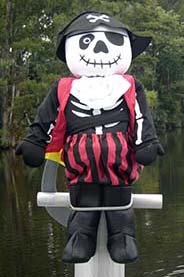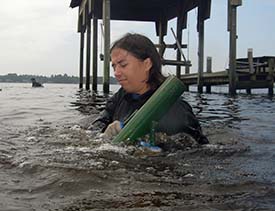ECU's 2006 Fall Field School
Project Journal
15 September 2006
By Tricia Dodds

It’s Friday! Although our adventures have certainly given us a memorable week, we could use a break after broken dredges, muddy dive gear, and potentially toxic water. We started out the morning at Site B, our new site after we had decided to abandon Site A until the water test results came back.

Our field school mascot Roger.

Michelle with the wanga danga.
Upon further investigation on SCUBA, the Padgett vessel appeared to be relatively intact, although some sections are buried underneath sand. It looks like the dredge equipment will be in our near future once again to move all of the sand. To ensure our success, we might have to perform some sort of sacrifice to the dredge gods before we commence dredging. Next, we set up fence posts around the Padgett vessel as datum points for our recording with this program known as Site Recorder. Pounding long fence posts into sand on an underwater site is actually not as easy as it looks. No problem though. After all, we are resourceful underwater archaeologists in training. Keeping in mind what our Australian professor Dr. Richards had taught us, Michelle and I used this device known as a “wanga danga” (always said with a fake Australian accent) to pound the fence posts in deep enough to keep them from moving. Another task successfully completed!

The group hard at work on the shoreline map.
By this time, the sun was shining brightly, and it was time for us to quit for the day out in the field at least. We spent the afternoon inside working on our scaled map of the shoreline from Site A and managed to make some progress before officially ending the day. In typical fashion, we welcomed the end of the week with a trip to Ham’s Restaurant and Brew House to celebrate our completion of our first full week in the field. Despite all of our challenges, we’ve made progress and definitely learned a lot. Although, I will have to admit that if one more person tells me that diving in mud is good for me because it builds character I might scream. Anyway, I’m looking forward to next week when we begin the Padgett vessel, and I’m optimistic that the dredge gods will be on our side.
For more information you can visit the ECU website at:
http://www.ecu.edu/maritime/index.htm
Return to Project Journal home page.

